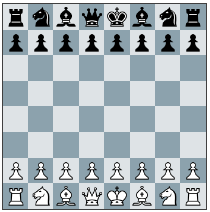It looks easy but important to understand ‘How to play chess’ with basics.
Once you follow some simple rules and guidance, the way ahead is easy and interesting!
Learning to play chess step by step is a great way to build your understanding of the game. Chess is a two-player strategy game played on a square board divided into 64 squares of alternating colors. Each player controls 16 pieces: one king, one queen, two rooks, two knights, two bishops, and eight pawns. The goal is to checkmate the opponent’s king, which means putting the king in a position where it is under attack and cannot escape capture.
Here’s a step-by-step guide to get you started:
Step 1: Board Setup
Place the chessboard between the two players in such a way that each player has a light-colored square in the bottom-right corner.
Set up the pieces as follows (from left to right, closest to each player):
Rook, Knight, Bishop, Queen, King, Bishop, Knight, Rook (for both players).
The row in front of the pieces should be filled with eight pawns for each player.
Setting up a chessboard perfectly involves actions to ensure that the board is oriented correctly and all the pieces are placed in the right positions. Here’s a further step-by-step guide to setting up a chessboard:
Step 1: Get a Chessboard and Pieces
Obtain a standard 8×8 chessboard with 64 squares of alternating colors (usually black and white).
Make sure you have all the correct chess pieces, including one king, one queen, two rooks, two knights, two bishops, and eight pawns for each player, with a total of 32 pieces.
Step 2: Orient the Board
Place the chessboard between the two players in such a way that each player has a light-colored square (white square) in the bottom-right corner.
Step 3: Position the Pieces
Starting with the back rank (the row closest to each player), arrange the pieces from left to right in the following order:
Rook, Knight, Bishop, Queen, King, Bishop, Knight, Rook.
Repeat the same arrangement for both players. The back rank should be filled with eight pieces.
Step 4: Arrange the Pawns
Place all the pawns in a row in front of the pieces. Each player should have eight pawns lined up in front of their pieces.
Step 5: Check the Setup
Once all the pieces are placed on the board, double-check to ensure that you have set up the board correctly and all pieces are in their proper positions.
Step 6: Begin the Game
With the board set up correctly, you are now ready to begin the game. Remember that White always moves first, and the players take turns making their moves.
Note: For formal competitions or games, it’s essential to follow the rules and standards set by the governing chess organizations. The FIDE (Fédération Internationale des Échecs) rules are widely recognized and used in official chess tournaments.
There are various myths and misconceptions on setting up the chessboard. Let’s have a look at some of these myths right away:
“The board should be set up with a dark square in the bottom-right corner.”
This is a common myth, but it is incorrect. The chessboard should always be set up with a light square in the bottom-right corner. This convention is followed universally in official chess rules and competitions.
“You should place the pieces randomly on the board.”
In reality, there is a specific and standardized arrangement of pieces on the chessboard. The back rank should always have the same order of pieces: rook, knight, bishop, queen, king, bishop, knight, rook. This setup ensures that both players have the same starting positions, creating a fair and balanced game.
“The queen should start on the square matching her color.”
Some believe that the queen should always start on her color (light square for white queen and dark square for black queen). However, this is not true. The queen always starts on her matching color, meaning the white queen starts on a light square, and the black queen starts on a dark square.
“Chessboards with uneven colors are acceptable.”
A standard chessboard always has 64 squares with alternating colors (light and dark). Some may mistakenly think that having uneven colors is acceptable. However, a proper chessboard must have a precise 8×8 grid with an equal number of light and dark squares.
“Pawns can start from any row on the board.”
Pawns must always start from the second row for both players. They cannot start from any other row, and they follow specific movement rules, including the option to move two squares forward on their first move.
“You can place pieces in any order on the back rank.”
The arrangement of pieces on the back rank (rook, knight, bishop, queen, king, bishop, knight, rook) is not arbitrary. It is based on the specific roles and movements of each piece. Placing them in a different order would not be correct.
Step 2: Movement of Pieces
The king can move one square in any direction: horizontally, vertically, or diagonally.
The queen can move any number of squares in any direction: horizontally, vertically, or diagonally.
Rooks can move any number of squares horizontally or vertically.
Knights move in an L-shape: two squares in one direction (horizontally or vertically) and one square perpendicular to that.
Bishops move any number of squares diagonally.
Pawns move forward one square, but they capture diagonally. On their first move, they have the option to move two squares forward.
Now lets look at few myths and misconceptions about movement of chess pieces.
Step 3: Objectives
The main objective is to checkmate the opponent’s king. This means putting the king in a position where it is under attack and cannot escape capture on the next move.
Other objectives include capturing the opponent’s pieces strategically and controlling key areas of the board.
The objective of the chess game is to checkmate the opponent’s king.
Checkmate is a position in which the opponent’s king is under attack (in check) and cannot escape capture on the next move. When a player’s king is checkmated, the game ends, and that player loses the game.
The ultimate goal of each player is to use their pieces strategically to put the opponent’s king in a checkmate position while also protecting their own king from being checkmated. In addition to achieving checkmate, players use various tactics and strategies to control key areas of the board, capture opponent’s pieces, and gain positional advantages.
It’s important to note that capturing the opponent’s pieces or controlling specific areas of the board are means to an end (checkmate) rather than the primary objective. While capturing pieces can be advantageous and weaken the opponent’s position, the ultimate focus of the game is always on the king.
Step 4: Basic Rules
White always moves first, and players take turns moving one piece at a time.
You cannot move through your own pieces, but you can capture your opponent’s pieces by landing on their square.
Pawns can be promoted to any other piece (except a king) when they reach the opposite end of the board.
Step 5: Special Moves
Several special moves that players make under specific conditions on the chess board and stage of the game. These moves add depth and complexity to the chess game and can provide tactical advantages when used strategically. Some of the key special moves in chess observed are:
Castling: This move involves the king and one of the rooks. On a player’s turn, they can move their king two squares towards the rook, and the rook is then placed on the square over which the king passed. There are a few conditions for castling: neither the king nor the rook involved can have moved previously, the squares between the king and rook must be unoccupied, and the king cannot be in check or pass through a square that is under attack. Once per game, a king can castle with one of its rooks. This involves moving the king two squares towards the rook and then placing the rook on the square over which the king passed.
En Passant: When a player moves their pawn two squares forward from its starting position and lands beside an opponent’s pawn, the opponent has the option to capture the first pawn “en passant,” as if it had only moved one square forward. This capture must be made immediately after the two-square pawn move; otherwise, the opportunity is lost. If a pawn moves two squares forward from its starting position and lands beside an opponent’s pawn, the opponent can capture the first pawn “en passant,” as if it had only moved one square forward.
Pawn Promotion: When a pawn reaches the opposite end of the board (the eighth rank for white and the first rank for black), it can be promoted to any other piece, except for a king. The player can choose to promote the pawn to a queen, rook, bishop, or knight, depending on the desired strategic advantage.
The Two-Square First Move: Pawns have the option to move two squares forward from their starting position on their first move. This move allows pawns to advance quickly and control the center of the board, but it also leaves them vulnerable to attacks by enemy pawns.
The Double Pawn Move: In some cases, a player can move two pawns simultaneously—one move for each hand. This is typically done for instructional or demonstration purposes rather than during official games.
The Threefold Repetition: If the same position occurs three times in a game, with the same player to move, and the same possible moves available, a player can claim a draw by threefold repetition.
The Fifty-Move Rule: If fifty consecutive moves are made by each player without any pawn movement or piece capture, a player can claim a draw due to the “fifty-move rule.”
Step 6: Practice
The best way to learn is to practice regularly. Play with friends, family, or online against other players or computer opponents.
Consider studying famous chess games, openings, and tactics to improve your sport.
Remember, chess is a game that rewards patience and strategic thinking. The more you play and learn, the better you’ll become.
Here are some key chess tactics to help you succeed:
Best practices in chess encompass various principles and strategies that can help improve your overall gameplay and increase your chances of success. Here are some essential best practices in chess:
Control the Center: Aim to occupy and control the central squares of the board (d4, d5, e4, e5) early in the game. This provides more mobility for your pieces and gives you greater control over the board.
Develop Your Pieces: Develop your pieces quickly and efficiently. Bring out your knights and bishops early, and try to avoid moving the same piece multiple times in the opening.
King Safety: Castle early to get your king to a safer position and connect your rooks. King safety is crucial, and leaving your king in the center can make it vulnerable to attacks.
Follow Opening Principles: Learn and follow basic opening principles, such as controlling the center, developing minor pieces, and ensuring king safety. Understanding common opening ideas can lead to a more solid foundation in the middlegame.
Plan Ahead: Always have a plan in mind. Consider your long-term goals and how each move contributes to achieving them. Look for potential tactics and threats from both sides.
Tactics and Calculation: Work on tactical puzzles regularly to improve your ability to spot combinations, forks, pins, skewers, and other tactical motifs. Accurate calculation is essential for successful chess play.
Piece Coordination: Aim for harmony and coordination among your pieces. Pieces should support each other and work together to achieve common objectives.
Evaluate Positions: Learn to evaluate the strengths and weaknesses of positions accurately. Identify imbalances and take advantage of them.
Control the Open Files and Diagonals: Place your rooks on open files, and use your bishops to control important diagonals. This improves the activity and influence of your pieces.
Endgame Proficiency: Study endgames, particularly king and pawn endgames. Mastering basic endgame techniques can lead to more wins and draw-saving opportunities.
Patience and Calculation: Be patient and avoid rushing decisions. Take your time to calculate variations and anticipate your opponent’s responses.
Review Your Games: Analyze your games, especially the ones you lose. Identify mistakes and missed opportunities to learn from them.
Stay Focused: Maintain your concentration throughout the game. Even a single oversight can have significant consequences.
Practice Regularly: Consistent practice is key to improvement. Play regularly, study chess books, watch instructional videos, and analyze games of strong players.
Stay Calm Under Pressure: Chess can be a mentally demanding game. Learn to stay calm and composed, even in challenging situations.


